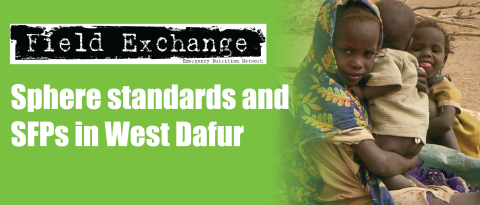Nutritional status of children and pregnant and lactating women in relief camps in post-tsunami Sri Lanka
Summary of published research 1
The post-tsunami survey reported below describes a decline in nutrition and health status amongst women and children, and makes recommendations to address these. However the investigators failed to recognise the relevance and adequately assess the influence of infant and young child feeding practices on the increased morbidity they observed in under two year olds, and explore what role the emergency response had in this. The signs are all there. Their data shows that three quarters of infants aged 6-12 months and 89% of children aged 12-24 months of age (the latter being the group with the highest prevalence of diarrhoea and wasting) had received milk powder in the previous 24 hours. This was despite the fact that most infants and young children were reported as breastfed. The focus group discussions described how hygienic preparation of milk was a problem in the camps. The highest rates of severe malnutrition (1.8%) were among under 1 year olds, who seemed to be living on breastmilk, powdered milk and biscuits. The authors did not assess exclusive breastfeeding rates in infants under six months, yet they concluded that "breastfeeding practices were satisfactory in infants under six months". This study highlights how the use of standard indicators to assess infant feeding practice and technical expertise in their interpretation is fundamental to assess impact appropriately. The authors recommendations also reflect the tendency to focus on commodity based responses to infant and young child feeding - adequate food rations, vitamin supplementation, supplementary feeding, with no mention of skills based support for breastfeeding, or the need to ensure a protective aid environment where indiscriminate distribution of milk powder does not feature (eds).
The December 26th tsunami that hit coastal areas of Sri Lanka in 2004, killed 30,527 people, displaced 773,636 and injured a further 15,686. The damage to infrastructure was of similar magnitude. More than 96,000 houses were destroyed and 26,538 partially damaged. To accommodate the displaced, 739 camps were established in temples, schools and churches. Survivors lost their loved ones and their assets and became dependent on relief assistance. Some suffered the devastating effects of exhaustion, bereavement, ill health and injury.
UNICEF, together with WFP, supported a nutrition survey, conducted by the Medical Research Institute of the Ministry of Healthcare and Nutrition, in camps housing displaced people. This involved a cross-sectional 30-cluster survey, where 30 children under five years of age were surveyed in each cluster, along with all pregnant and lactating women in selected camps. Mid upper arm circumference (MUAC) was used to assess the nutritional status of pregnant women (MUAC <= 230 mm for acute malnutrition and <=207 mm for severe acute malnutrition). In lactating women, Body Mass Index (BMI) was calculated (BMI<18.5 considered underweight and >24.9 as overweight).
Before the survey, under-nutrition was the primary development challenge for Sri Lankan children. A Demographic and Health Services (DHS) survey in 2000 indicated that 14.0% 13.5% and 29.4% of children under five were wasted, stunted and underweight, respectively 2. In comparison, the post-tsunami study assessed a total of 878 children and found 16.1%, 20.2% and 34.7% to be wasted, stunted and underweight.
The prevalence of each indicator was higher in boys than in girls. During the two weeks before the survey, 69.5% of the children had acute respiratory tract infections and 17.9% had diarrhoea. Although the general food distribution was well in place, the food supply lacked diversity and 70.9% of the children did not get appropriate supplementary food. The prevalence of under-nutrition among pregnant women and lactating women was 37% and 31% respectively. The highest prevalence of wasting was among children between 12 and 23 months of age (31.2%). This age group also experienced the highest prevalence of acute respiratory tract infection and diarrhoea. Although this study found a level of wasting higher than the trigger point of 15% used by the World Health Organisation (WHO) to indicate a public health concern, there was a very low level (0.8%) of severely wasted children. The highest prevalence of severe malnutrition was in infants under 1 year (1.8%).
Only 33.2% of children between 12-23 months had received their vitamin A megadose (routine vitamin A megadose supplementation is provided for children 9-18 months of age in Sri Lanka through the maternal and child health clinics). While 83.2% of infants 6-12 months of age were currently breastfed, nearly one quarter (23.6%) had received milk or milk products in the previous 24 hours. Milk powder was supplied by the government. While 99% of infants under six months were described as currently breastfed (not using 24 hour recall), exclusive and predominant breastfeeding rates were not measured. More than two thirds of the children did not receive micronutrient-fortified supplementary foods.
The authors of the study recommended that a one-day vitamin A megadose supplementation campaign for children aged 6 months to 5 years be launched in tsunami-affected areas; that supplementary food be supplied for all children under five years and to pregnant and lactating women in the areas for a minimum of one year; that nutrition surveillance systems be established in affected areas; and that social services departments and camp managers be advised to provide nutritionally complete food rations for children.
1 Jayatissa. R, et al (2006). Assessment of nutritional status of children under five years of age, pregnant women, and lactating women living in relief camps after the tsunami in Sri Lanka. Food and Nutrition Bulletin, vol 27, no 2, pp 144-152.
2 In children, the cutoff point for stunting, wasting, and underweight was a z score below - 2SD of the reference value
Imported from FEX website


